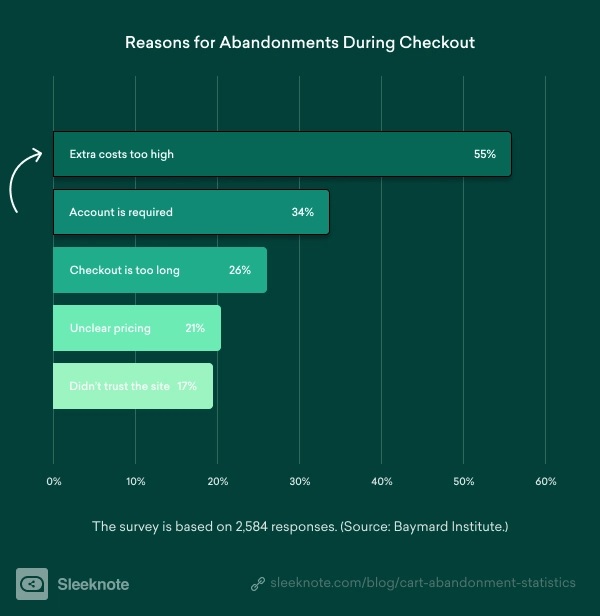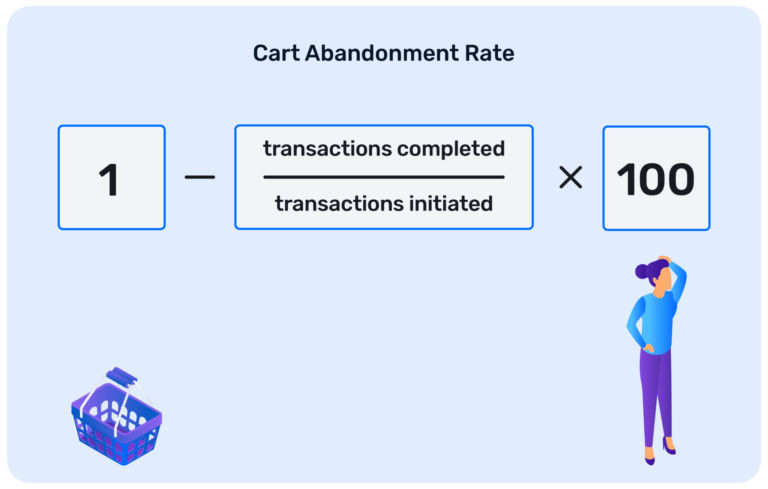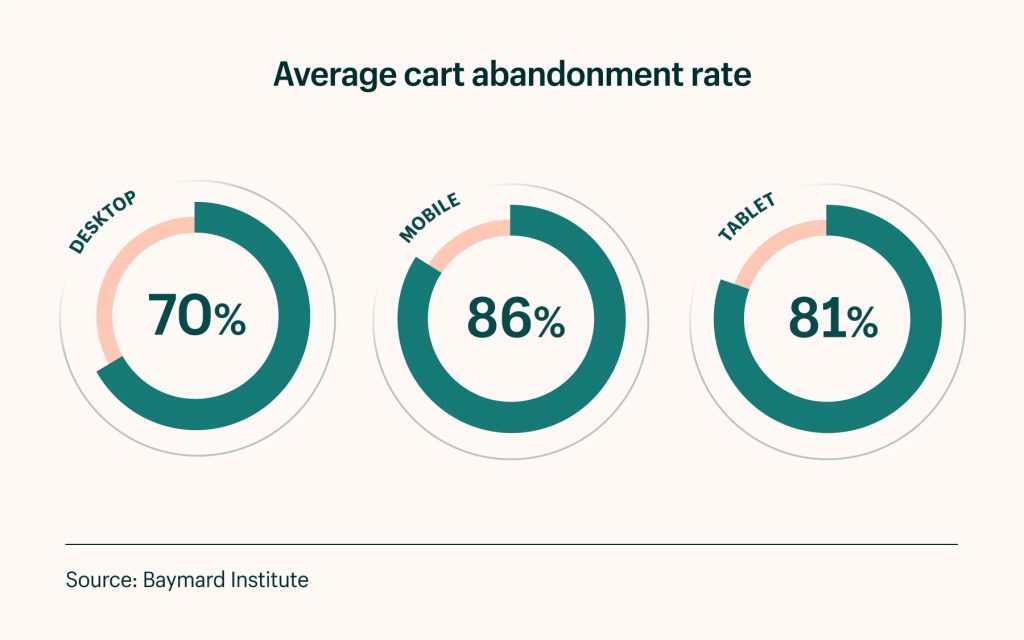For as many years as it has existed, eCommerce has dealt with cart abandonment. For various reasons, from a simple change of heart to deep website problems, “online window shoppers” remain unconverted. This eCommerce mainstay is not leaving anytime soon – but retailers can actively work to address it. To help you do so, let us explore some key practices for decreasing eCommerce cart abandonment.
Table of Contents
What is eCommerce shopping cart abandonment, and why does it happen?
As the name states, Cart abandonment is the practice of abandoning one’s shopping cart after having added products to it. Perhaps unsurprisingly, it’s a prevalent practice; Statista finds the average cart abandonment rate consistently stays near 70%.
Many factors contribute to it, some outside of retailers’ control. Examples of the latter include changes of heart, indecisiveness, and wanting to conduct more market research. Other factors do somewhat lie within retailers’ power, however, as Sleeknote’s study finds:
What are the benefits of decreasing eCommerce cart abandonment?
Naturally, tackling cart abandonment rates does carry many benefits. Here we may briefly outline the three main ones.
Also Read: Step by step guide to developing a Shopify eCommerce store
#1 Increasing revenue
First, each cart abandonment prevented effectively increases your conversion rates. After all, an abandoned cart is a failed conversion by definition.
Doing so will, in turn, directly increase revenue, as more purchases will be completed. Depending on your Average Order Value (AOV), even a 5% improvement can make a stark difference in final revenue.
#2 Reducing customer churn
Second, cart abandonment can usually indicate a customer lost for good. They will often not return even post-optimizations if they have abandoned their shopping intentions because of reasons within your control.
Naturally, reducing customer churn this way is vital for revenue as well. Especially if your Customer Lifetime Values (CLVs) are high, it’s highly beneficial to have repeat purchases fuel your monthly earnings.
#3 Increasing customer retention
On that subject, eliminating cart abandonment’s underlying factors can drastically increase customer retention rates. Offering customers clear, quick, and frictionless shopping experiences will most often inspire trust.
This metric is equally noteworthy for many reasons. Acquiring new customers costs up to 7x as much as retaining old ones. In addition, repeat customers shop more frequently and place bigger orders than new customers do.
Calculating eCommerce cart abandonment rates
Finally, calculating your abandonment rates is relatively easy. As Bolt’s following illustration explains, all you have to do is divide transactions completed by transactions initiated, subtract from one, and multiply by 100.
Tips for decreasing eCommerce cart abandonment
Having covered the basics, let us now delve into actionable suggestions – with the above in mind.
#1 Be completely transparent about final costs
First and foremost, you must ensure shoppers clearly understand all costs upfront. Remember, this is the primary reason for cart abandonment, and customers don’t take kindly to hidden costs. They don’t just reduce conversion rates either; they also severely hamper customer trust and lower customer retention.
To address this, you may look for such ways as website widgets to quickly disclose:
- Shipping and import costs
- Taxes
- Other fees
In this regard, offering free shipping wherever possible also helps tremendously. It increases cost transparency, but it also makes customers more likely to shop from you.
#2 Allow guest account purchases
The second most prevalent reason for cart abandonment is the requirement to create an account. Modern shoppers expect frictionless shopping experiences, as we’ll cover next, and requiring that they create an account directly prevents them.
The simple solution for this is, of course, allowing for guest account checkouts. Then, you may prompt your customers to create an account for easier future purchases on the confirmation page. An additional benefit of this practice is that it’s essentially an opt-in. Leads acquired this way are more qualified, as they’ve already converted once, saving your marketing and sales teams time.
#3 Simplify your checkout process
Your third step toward decreasing eCommerce shopping cart abandonment rates is simplifying your checkout process. As the research above finds, long, complex checkout processes are the third leading reason shoppers abandon their carts.
To do so, you may:
- Limit your input fields to the absolute minimum required
- Add a progress indicator bar to your checkout page
- Allow customers to edit their choices without navigating to previous pages
- Improve the loading speed of each page
- Use visual cues like animations creatively to decrease perceived loading times further
As with all marketing endeavors, simplicity is vital.
#4 Optimize for mobile devices
Next, it is equally crucial that you specifically optimize your website for mobile devices. The reason for this is simple; Baymard Institute finds they have higher cart abandonment rates, as Shopify notes:
To do so, you may:
- Examine your website, product pages, and checkout process on smaller mobile screens
- Opt for a clean, mobile-friendly web design
- Serve mobile versions of your pages wherever appropriate
Especially as social commerce takes hold and mobile traffic exceeds desktop traffic, catering to this demographic is essential.
#5 Use trust signals
Another crucial practice toward decreasing eCommerce cart abandonment is leveraging trust signals to inspire confidence in potential shoppers. This factor may rank 5th among the main ones but still causes a sizable 17% of all cart abandonments.
Trust signals you may use include:
- https over http
- Symbols of PCI-DSS compliance
- Social proof, such as customer reviews, ratings, and User-Generated Content (UGC)
If you engage in SEO, trust signals will also boost your authoritativeness and with it, your rankings and organic traffic.
#6 Offer live chat support
Still, despite your best efforts, some customers will not abandon their carts because of you. Instead, they may be undecided, have unanswered questions, etc. You may approach this customer segment directly by offering live chat options on relevant pages.
This feature is now deeply appreciated by audiences across all industries, and eCommerce website services ones do not differ. Live chat can help answer their questions on time or offer them customer support should they need it. You may thus integrate it across your checkout flow to prevent abandoned carts and foster trust alike.
Also Read: What Ecommerce capabilities Can WooCommerce Open Up For You
#7 Use exit-intent popups
Similarly, you may prevent some cart abandonments by utilizing exit-intent popups that emerge as customers prepare to leave. As Sumo’s research finds, exit-intent popups are remarkably effective despite their poor reputation.
To increase their effectiveness, you may carefully polish their copy. Incite urgency through countdown timers, suggest exclusivity, or offer them incentives to stay. You may not prevent all abandonments this way, but exit-intent popups can demonstrably increase your conversion rates.
#8 Send follow-up emails
Finally, decreasing eCommerce cart abandonment rates will never fully succeed. When about 70% of customers abandon their carts, many will inevitably slip through. After the fact, you may attempt to re-engage with those customers through follow-up emails.
As you do, remember to:
- Time emails correctly; do not send follow-up emails immediately, and do so with time zones in mind
- Personalize your copy; use any information you have to make your copy relevant and personal
- Address their pain points; offer discounts or other incentives to address the likely reasons they abandoned their carts
As with all marketing endeavors, insistence is critical. Remember, every customer reclaimed is a direct benefit to your business.
Conclusion
Decreasing eCommerce cart abandonment rates is a perpetual challenge for online retailers. Among other adverse effects, cart abandonment decreases final revenue, increases customer churn, and reduces customer retention rates.You may begin by addressing the primary reasons for them through clear costs, quick and simple checkouts, and mobile-friendliness. Then, you may inspire confidence through trust signals and live chat options. Finally, you may prevent some through exit-intent popups and reclaim some customers via follow-up emails.
You may never entirely eliminate cart abandonment with rates being so high, but every reduction helps.aaaaa





















